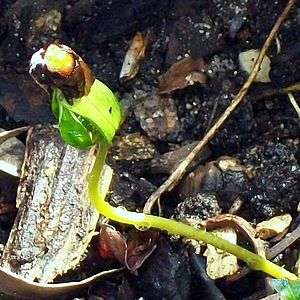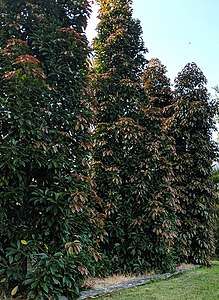Elaeocarpus eumundi
Elaeocarpus eumundi is a mid-sized Rainforest tree situated in eastern Australia. It grows from the Richmond River, New South Wales to the McIlwraith Range at Cape York Peninsula (Far North Queensland). This tree is considered rare in New South Wales.[1] Commonly known as the Eumundi Quandong, or Smooth Leafed Quandong.[1]
| Elaeocarpus eumundi | |
|---|---|
| Elaeocarpus eumundi - new growth | |
| Scientific classification | |
| Kingdom: | Plantae |
| Clade: | Tracheophytes |
| Clade: | Angiosperms |
| Clade: | Eudicots |
| Clade: | Rosids |
| Order: | Oxalidales |
| Family: | Elaeocarpaceae |
| Genus: | Elaeocarpus |
| Species: | E. eumundi |
| Binomial name | |
| Elaeocarpus eumundi | |
Elaeocarpus eumundi grows in warm temperate, riverine, and Tropical rainforest. It's a dense foliage Evergreen tree (Native to Australia).[2] Endemic to Australia, widespread, occurs in north-eastern Queensland and continues on southwards as far as north-eastern New South Wales.[1][3]
Description
Elaeocarpus eumundi can reach to 30 metres (98 feet) tall, and 50 cm (20 in) in trunk diameter in the wild, but is much smaller in cultivation. The outer bark is fairly smooth, grey in colour with corky bumpy irregularities. The trunk is buttressed at the base. In regular gardens it reaches 10 to 25 metres tall and spread from 3 to 6 metres in width when mature.[2]
Alternate glossy leaves are bunched together at the ends of branches. Margins (edges of the leaf) bluntly toothed in the leaf's upper half, though sometimes not toothed at all.[3] Leaves of varying shapes, often obovate, 6 to 13 cm long with a long tip and is commonly 2 to 4 cm wide.[3] Leaf venation is conspicuous and raised on both the upper and lower surface. However, with the flowers the Sepal are about 1.4 cm long whereas the Petal are measured up to 11 x 4 mm, divided at the apex into about 17-20 lobes, 1 to 1.5 mm long. The Stamen are about 20 mm, whereas the Ovary (botany) is glabrous (smooth).[3]
Cream coloured scented flowers form on racemes between November and December (Summer). The fruit is a blue drupe egg shaped (globular-ellipsoid) are about 1.5 x 1.1 cm in dimension and contains a rough wrinkly hard centre (stone shell) with one or two seeds inside it.[3] Fruiting occurs in May to June. Like many Australian Elaeocarpus trees, germination is slow and difficult, however cuttings prove more successful.
Uses
Eumundi Quandong is well suited as an ornamental tree.[4] It's unclear if the fruit is safe for human consumption many sources don't mention it (so it's best not to put it into your mouth), although this tree are cultivated for the sole purpose to attract nectar eating birds, and seed eating birds.[4] It's grown as a wind break/ feature tree and used occasionally for timber.[5] It is a "Beloved beautiful native quandong tree, very disease resistant and needs little maintenance. Stunning bronze new leaf colour and elegant shape make this a very attractive addition to all but the smallest of outdoor spaces. Very popular street tree, responds well to hard pruning if necessary."[6]
The “traditional” edible Quandong is the Santalum acuminatum also known as the desert quandong, this species especially its fruit, is also referred to as quandong or native peach.
Other trees from the genus Elaeocarpus that have edible fruits includes: Elaeocarpus angustifolius, refer to as the Blue Quandong, and Elaeocarpus reticulatus known as the Blueberry Ash.
Gallery
 Elaeocarpus eumundi seedling
Elaeocarpus eumundi seedling Eumundi Quangdong flushes of bronze- red in its new growth of leaves.
Eumundi Quangdong flushes of bronze- red in its new growth of leaves. Elaeocarpus eumundi glossy leaves
Elaeocarpus eumundi glossy leaves Elaeocarpus eumundi leaves
Elaeocarpus eumundi leaves.jpg) Elaeocarpus Eumundi in a public space
Elaeocarpus Eumundi in a public space Eumundi Quandong foliage
Eumundi Quandong foliage
References
- http://plantnet.rbgsyd.nsw.gov.au/cgi-bin/NSWfl.pl?page=nswfl&lvl=sp&name=Elaeocarpus~eumundi
- "Elaeocarpus eumundii | Andreasens Green Wholesale Nurseries". Retrieved 2020-01-10.
- "Factsheet - Elaeocarpus eumundi". keys.trin.org.au. Retrieved 2020-01-10.
- "Elaeocarpus eumundi – Eumundi Quandong | Gardening With Angus". www.gardeningwithangus.com.au. Retrieved 2020-01-10.
- "Eumundi Quandong Tree - Elaeocarpus eumundi". www.daleysfruit.com.au. Retrieved 2020-01-10.
- "Elaeocarpus Eumundi". www.australianplantsonline.com.au. Retrieved 2020-01-10.
- Floyd, A. G. (1989). Rainforest Trees of Mainland South-eastern Australia (1st ed.). Port Melbourne: Elsevier Australia - Inkata Imprint, copyright Forestry Commission of New South Wales (published 1989-12-01). p. 113. ISBN 0-909605-57-2. Retrieved 2009-06-23. (other publication details, included in citation)